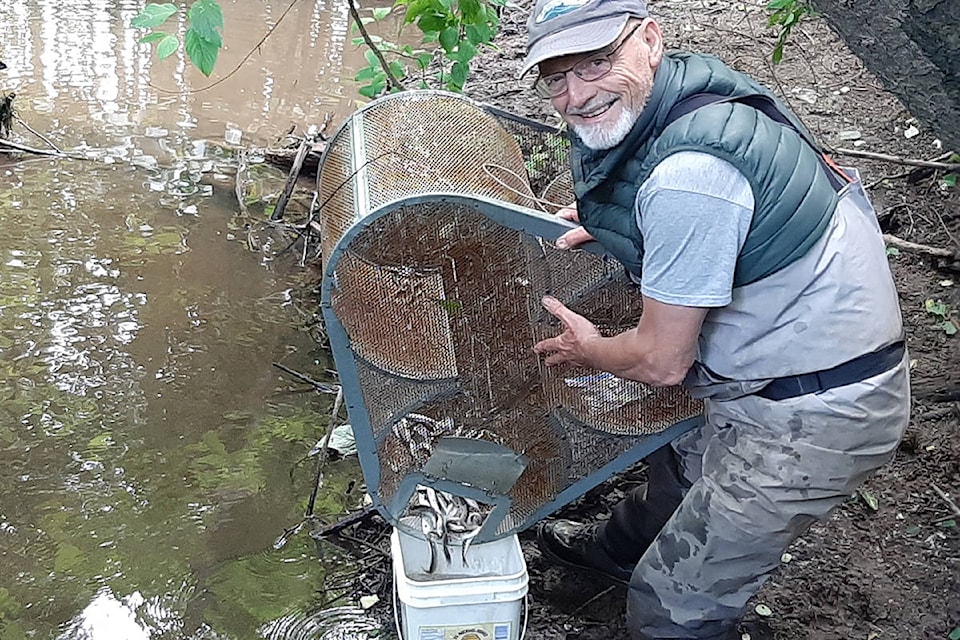You may have seen people with chest waders and buckets of fish in the Comox Valley Exhibition grounds lately; they are Tsolum River Restoration Society (TRRS) volunteers rescuing stranded wild juvenile coho salmon from Towhee Creek.
This small but mighty creek starts in the School District#71 forest up the hill from G.P. Vanier Secondary school and flows down beside the soccer turf field, crosses under Headquarters Road near the curling rink, then meanders through the CV Exhibition Grounds before entering the Tsolum.
So far in 2021, over 7,000 wild salmon smolts have been captured from Towhee Creek ponds using small traps and beach seines, and then transferred into the Tsolum River. Typically, during high winter flows in the Tsolum, young fish move into smaller quieter areas such as Towhee Creek and other off-channel areas to seek refuge from floodwaters. By around late April, these fish are close to 10 cm. in size and get the urge to migrate to the ocean as smolts. Due to factors such as less spring rainfall, timing of the migration, and low flows, many of these fish are stuck and unable to leave Towhee Creek. TRRS is trying to come up with a longer-term solution, but in the meantime assists these valuable wild fish in getting out of the creek into the Tsolum so that they can continue their migration. Thanks to GP Vanier Students, Youth in Ecological Restoration (YER), and our many dedicated volunteers of all ages for helping with the fish rescue operations in 2021
There are many other small seasonal creeks in the Tsolum watershed that have good winter flow that attracts young coho and trout. While at first glance these tributaries might look like ditches, they can be vitally important for wild salmonids. Chillie Creek, for example, that flows under Dove Creek Road has high numbers of coho juveniles that are currently at risk of dying due to poor water quality and lack of water flow. Dissolved oxygen levels are reaching critically low levels and on June 5th hundreds of dead juveniles were observed floating in the stream. We are investigating and collecting data on this “fish kill” to see if there may have been other circumstances including the possibility of a deleterious substance that made its way into the creek to trigger this massive die off. At the same time, volunteer crews are trying to rescue the remaining coho that have survived in Chillie Creek.
Towhee Creek showcases the incredible importance of tiny tributaries that are seasonally very attractive to salmonids and Chillie Creek reminds us that when flows are very low, dissolved oxygen levels can become lethally low to aquatic life; and any inputs of nutrients, chemicals, or road run-off can quickly alter water chemistry, and can be the tipping point for fish populations that are already stressed.
The TRRS is under contract with Environment Canada to check water quality in the Tsolum every two weeks, year-round to monitor copper levels in the water. This is a way to monitor the effectiveness of the mine site cover that was installed over the Mount Washington Copper mine in 2010. TRRS reminds residents and visitors that the Tsolum River is permanently closed to all fishing, including catch and release, to allow fish stocks to recover from 50 years of mine site pollution.
There are ways that you can help contribute to stewardship of our streams and rivers in the Comox Valley. If you see stranded fish in your neighbourhood, whether in a ditch or local stream, please contact the TRRS at 250-897-4670. To volunteer, become a member or make a donation to the society, visit
ALSO: Increase in Puntledge River flows for salmon migration



